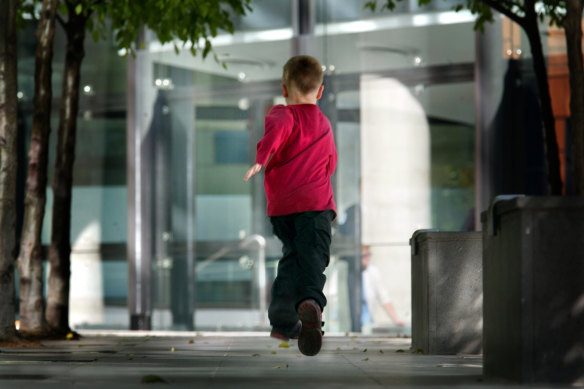Save articles for later
Add articles to your saved list and come back to them any time.
Schools that prioritise wellbeing over academic instruction could ultimately be doing a disservice to students, an expert specialising in analysis of concerning behaviour in education says.
And her views are backed by other education experts who warn that schools could be tipping the balance between wellbeing and learning too far to one side.
Wellbeing has been elevated alongside learning as one of the two core goals of Victoria’s school system, and a $200 million mental health program is under way.
Student wellbeing has been elevated alongside learning as a core outcome in Victorian schools. Credit: Joe Armao
Dr Erin Leif, a senior lecturer at Monash University’s School of Educational Psychology and Counselling, said the emphasis on supporting students’ wellbeing had gone too far and threatened to crowd out time that should be spent on academic learning.
“We need to support their [students’] wellbeing,” Leif said. “But what happens when we take the approach that we delay engaging our students’ effective learning for longer and longer, and they fall further and further behind academically?”
She said wellbeing should be integrated with, and complementary to, academic instruction.
“I’ve certainly heard examples of schools where they’ve made a decision to put academic instruction on hold, or lessen the amount of academic instruction during the school day so that they can do more activities specifically focused on student wellbeing,” she said.
“The risk in taking that approach is that students may fall further behind academically.”
Victorian schools can tap into a “mental health menu” of programs aimed at improving wellbeing and reducing anxiety. The programs range from therapy dogs, song rooms and whole-school art projects to coaching on trauma-informed teaching practices. Mental health officers are also being placed inside every government school in the state.
At one primary school where students were struggling with reading and literacy after COVID-19, the approach chosen was to reduce academic instruction by 20 per cent and replace it with unstructured activities such as “yarning circles or craft activities or other types of non-academic but social emotional-type activities”, Leif said.
Victorian schools have a “mental health menu” of programs to help children.Credit: Angela Wylie
Following the pandemic lockdowns, classrooms have been in the grip of a behavioural crisis and an increase in school refusal. Senate inquiries into both issues are under way.
Research published in March by the University of Sydney showed that adolescents were among the worst affected by COVID-19 when it came to mental health. A Resolve Strategic survey taken last year found that one in four young Australians thought about suicide in the previous two years and 14 per cent attempted self-harm.
Leif said re-engaging with students following the pandemic was hard, but the best way to help them with their anxieties was to set up situations where they went into school and they were successful.
Schools risked falling into a “wellbeing trap” when they focused reactively on each student’s individual happiness, Albert Park College principal Steven Cook said.
He said student wellbeing was important but should be centred on building children’s resilience, rather than trying to solve their problems.
“Making education intellectually challenging and contemporary is difficult. Setting our sights low around a multiplying list of wellbeing issues is far easier,” Cook wrote in his recently published book, From the Ground Up.
Today, principals and teachers must look out for children’s mental wellbeing, diet and dentistry, all issues that would have previously been the concern of families.
“While giving schools responsibility for broader welfare issues may be necessary and progressive, it certainly creates problems,” Cook wrote.
“Burdened with too many responsibilities, our secondary schools are finding it increasingly difficult to do what used to be considered their basic job, imparting knowledge to get good careers which our economy needs to stay innovative and productive.”
Harriet Hiscock, a pediatrician and professor at Murdoch Children’s Research Institute, said researchers from the institute followed 1200 children from the age of nine to 11.
NAPLAN data found that students with emotional problems at age nine had poorer numeracy at age 11, and were 30 NAPLAN points behind their peers.
“Learning is really important, but if you don’t balance that out with support for children’s mental health and wellbeing it’s likely … that’s going to affect their concentration, school attendance, and that can all lead to poorer learning outcomes,” she said.
Hiscock said it was a “tricky balance for schools” to ensure students didn’t fall behind, but that wellbeing could be fostered in an engaging way that aligned with the curriculum.
“It’s hard to say, blanket, it’s being well or not done well. It’s variable across schools. There’s always room for improvement and supporting schools to do that.”
Grattan Institute school education program director Dr Jordana Hunter said the institute had heard of some schools that viewed themselves as more focused on wellbeing than on academic achievement.
Students who were behind in their learning were at greater risk of disengaging, Hunter said.
“There’s a complex relationship between student wellbeing and learning outcomes, so certainly for students who are really struggling with their learning, that can have a really negative impact on their wellbeing and engagement in class,” she said.
“One of the most effective things schools can do is to ensure kids are on track with their learning.”
Victorian Principals Association president Andrew Dalgleish said prioritising wellbeing did not have to come at the expense of academic instruction.
“It’s not an and/or; it’s one alongside the other,” he said.
“We are working with human beings, not making widgets for cars. Wellbeing and engaging with young people is a fundamental part of the education package. If a child is not having their hierarchy of needs met – food, shelter, love – then it’s pretty hard to get into the teaching space.”
A government spokesperson said student learning remained at the centre of all Victorian government schools, as evidenced by outstanding NAPLAN results.
“We know that a quality curriculum and the very best teachers, together with access to mental health and wellbeing support, is essential for students to be their best at school,” the spokesperson said.
“We’ve invested more than $600 million in student mental health and wellbeing programs so that Victorian kids are well supported to learn and excel.”
The Morning Edition newsletter is our guide to the day’s most important and interesting stories, analysis and insights. Sign up here.
Most Viewed in National
From our partners
Source: Read Full Article




